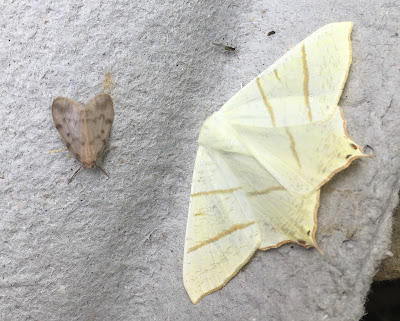Although the hawk moths are the runaway favourite with visitors here who are unfamiliar with moths, several less dramatic species also find fans. The jet-plane shape of the Angle Shades never fails to attract admiration while the White Ermine hits a soft spot in pretty much everyone.
 Another is today's lead moth, the Buff-tip, because of its party trick shown in my first two photos. It really does look like a broken twig, down to its own version of lichen as well as the snapped-off ends. Which of these two is the moth and which the twig? I think that you will get it right after a close look, but I'm equally sure that the moth almost always hides successfully from passers-by. It's a bit of a puzzle to me, though, why natural selection has led to such a close match. Birds are moths' greatest predators (along with bats) and their eyes see things differently from ours. I've always understood movement to be crucial in giving the game away, but I must read more and see if an unfamiliar outline arouses suspicion - which would be a sound argument for moths melting into their surroundings as much as they can.
Another is today's lead moth, the Buff-tip, because of its party trick shown in my first two photos. It really does look like a broken twig, down to its own version of lichen as well as the snapped-off ends. Which of these two is the moth and which the twig? I think that you will get it right after a close look, but I'm equally sure that the moth almost always hides successfully from passers-by. It's a bit of a puzzle to me, though, why natural selection has led to such a close match. Birds are moths' greatest predators (along with bats) and their eyes see things differently from ours. I've always understood movement to be crucial in giving the game away, but I must read more and see if an unfamiliar outline arouses suspicion - which would be a sound argument for moths melting into their surroundings as much as they can.I witnessed two attempts at predation yesterday when a couple of Elephant Hawks - the glorious pink moth below - decided to fly off from the trap while I was doing my photos. One of our many blackbirds zoomed in at high speed and gave chase, but the moths - both of them - put on an excellent display of aerial strategy, jinking sideways so that the bird overshot and took ages to circle back and have another go. Exactly the same thing then happened before the moths reached safety in the leafy branches of our big oak.
I have set myself a bit of a task today by showing you a series of micros, moths which are far from easy to ID. I am guessing that the one with the Elephant and the less battered one below are both members of the Cnephasia family whose separate identities - and there are quite a few of them, with only marginally different wing patterns - cannot be identified precisely without dissection of the genitalia. Not my field.
The beautiful micro above is an easier task; it has to be Catoptria pinella. But then we move on to another big family of lookalikes, the Scoparids. I go for Scoparia pyralella for the first two and Eudonia lacustrata for the third but I will check with the gurus of the Upper Thames Moths blog.
Next we have two examples of the Marbled Orchard Tortrix, Hedya nubiferana, followed by Agriphila straminella alongside a Scarce Footman macro. Don't they have long names for such little specks?
And now for this apparently distinctive chap in the middle of the first picture below and on its own in the second, which has given me trouble. The closest I can get in the Micro Moth Bible is Spatalistis bifascina but that is only locally common so, again, I will have to check with UTM.
Next, I believe we have a very long-standing regular, albeit rather battered, Archips podana, and then we're back in Macro Mothland with a Muslin Footman cosying up to a Swallowtail followed by a Common or Lesser Common Rustic in a rustier shade than the ones I've shown already this year. A rusty Rustic.
To end with, another photo of our many Red Admiral butterflies about at the moment. Glorious creatures which would get on well, I imagine, with Scarlet Tiger moths. I like giving space here to both.















Hi Martin
ReplyDeleteLovely moths. I personally would have had *straminella* as Chrysoteuchia culmella, but struggle with Grass moths almost a much as with Pugs, so can only suggest a second look by yourself.